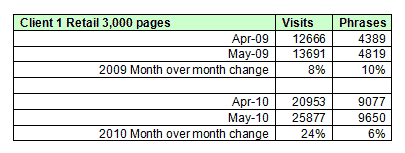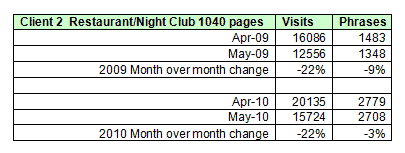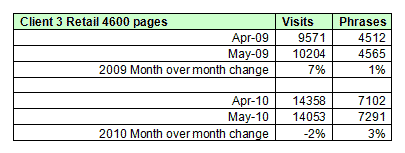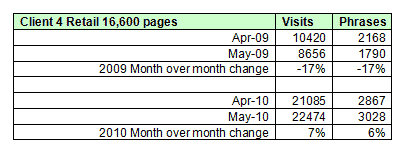By now, most of us know about the big change Google performed this past month to the algorithm known as the “Mayday” update. We know also that it directly affected deeper page content and long tail SEO. Several people, including Brett Snyder over at SEER Interactive have come out with opinions on its impact on their sites, with mixed messages coming from across the industry as to whether there was a positive impact or a negative impact. I took it even further though, and have studied the impact by comparing multiple months and year over year across four client sites involving over 24,000 pages of content, and 248,000 site visits that came to those sites via more than 69,000 keywoord phrases.
Don’t Be Fooled
Now before I go any further, I need to say that you may not know that I was a crime statistician a couple decades ago, who learned that you can make statistics prove anything you are seeking to prove. There are several ways you can go about this including:
- Manipulate the Numbers
- Leave Out Critical Portions of Data
- Include Otherwise Irrelevant Data
- Use Marketing Spin
- Baffle Your Audience With Bull$@*#
Other Factors to Consider
In addition to the intentional manipulation of statistical data, there’s the issue of other factors that must be considered when drawing conclusions about this, or any update we learn of.
What if Google made sixteen other changes around the same time frame, and DIDN’T tell us about those? Given that they make hundreds of changes every year, that’s quite possible.
What if the change in visitor activity was even partially as a result of work that person performed the previous month and that work was just now bearing fruit?
What if any of these increases or decreases was as a result, at least partially, of someone’s competitors and the SEO (or lack thereof) on those competitor sites?
What if some of those changes was due to seasonal factors that nobody seems to be mentioning?
So as you read this article, and look at my statistics, just remember all of this. Because at the end of the article I will offer some conclusions which speak to what we all need to focus on as a result of the Mayday change. …
One Additional note
Before I go over my data – if you are reading this article on the day it’s published, I may not be able to reply to comments right away, given that I’m scheduled to be up in Seattle for SMX Advanced. But please – don’t let that stop you from commenting- I’d love to get your opinion on all of this. And if you’re bold enough to draw conclusions about my own data, I’d be tickled pink!
Client #1
Client 1 is a retail client, with 100% of their sales coming through their online presence. They’ve got roughly 3000 pages indexed at Google at any given time.

From April to May of this year, overall Google organic visits jumped at a higher rate than they did from April to May of last year while at the same time, the total number of keyword phrases used to find Client 1’s site rose as well, but at a much lower rate as compared to last year’s month over month change.
Sure, you might say that this means the MayDay update caused a drop in the growth of keyword phrases. If you want to say that. Yet the truth is that we work on this client’s site continually, month in and month out. And it’s impossible to say that any of this growth or lack of comparative growth, was as a result of our work, the Google Mayday changes, or some other factor. But at least we got that higher visitor count. 🙂
Client #2
Client 2 is a very popular eatery and entertainment night spot, with over 1000 pages indexed.

As you can see, year over year, site Google organic visitor activity drops off significantly between April and May. In fact, this year’s drop is almost identical to last years drop in visits. Yet something else to note is that the total number of phrases searched, while falling this year like they did last year, didn’t fall as far. This tells me that more people were clicking through to the site relative to the total number of phrases searched.
Client 3
Client 3 is an online retailer with a whole lot of products – over 4600 pages total.

Client 3 saw a drop in Google organic visits while seeing more phrases searched in this year’s April to May comparison. Isn’t THAT interesting?
Client 4
Client 4 is also a retailer – with the most pages of any site reviewed for this study. Over 16,000 pages indexed at Google, as a matter of fact.

Sadly, as you can see by these statistics, even though Client 4 has infinitely more pages than any of the other sites in this study, they sure don’t act like it. I mean – look at that Google organic search volume and compare the total number of pages on the site to total Google organic visits, and then go back and look at the 3 other clients in this article. Just goes to show you – just because you have the most pages on your block, it doesn’t mean you’re going to get the most visits, let alone sales!
In any case, year over year changes were about the same for both visits and phrases used. Except that last year from April to May there was a big DROP in visits and this year, from April to May there was a 7% increase.
Conclusions
I think it’s obvious from these numbers, that the Google Mayday update helped all four of these clients. Just by looking at the year over year and month over month statistics proves that out.
Okay, no it doesn’t. That claim is actually the lamest joke I think I have told all week. Because like I said at the beginning of this article, there’s honestly no way to know.
And thus, I conclude that anyone who tells you they have anything resembling an “informed” opinion as to whether the Mayday update was good, or bad, is just puffing themselves up and pulling your chain.
Actions To Take Because of the Mayday Update
Here’s where I think we need to be – more unique content needs to be added to 2nd, 3rd and 4th tier pages. Better linking needs to take place within the site itself that improves the importance of those pages from Google’s perspective. Those pages need more inbound links going directly to them. And more needs to be done through social media and other online authority building and brand identity confirmation perspectives.
Which is something you should have been doing (or telling your clients to do), for at least the past three years. Because that’s how long I’ve been advocating those very things. And it’s what anyone with half a brain in our industry says as well.
So get to work, people! And have a nice day.



